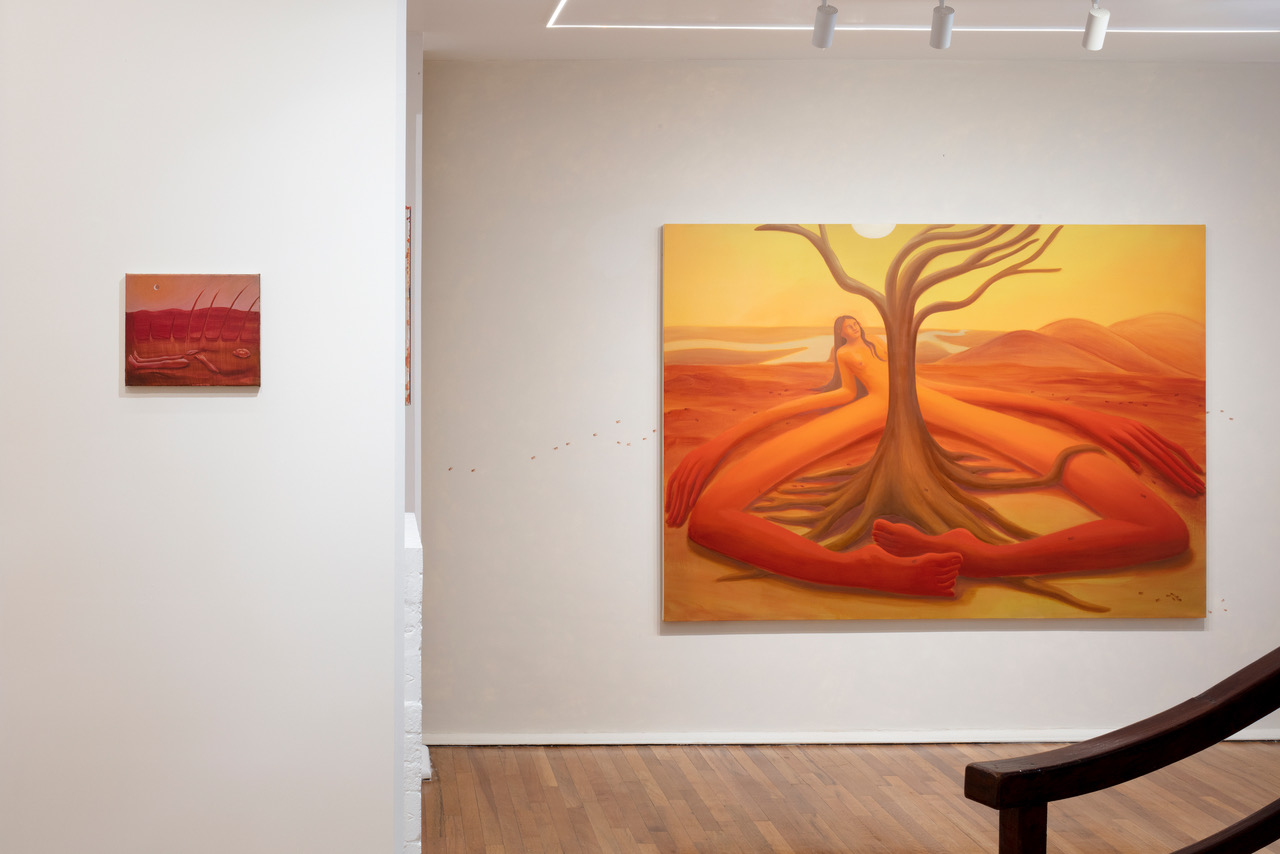
Paula Turmina
Terrenos Maleables
Exhibition
-> Sep 17 2024 – Oct 19 2024
Ambar Quijano presents Terrenos Maleables by Brazilian artist Paula Turmina.
Unsettling and mesmerizing landscapes that seem familiar yet at times otherworldly envelop one’s body through a play with scale, a multiplicity of thin layers, and a series of symbiotic dynamics. Ambiguous and fluid, like the genderless figures or elongated representations of autonomous body parts within them, Paula Turmina’s (Brazil, 1991) paintings lean towards transportive experiences of and with the landscape by evoking bodily connections to the same. Bodies become part of their environment by mimicking the world around them and vice versa —a head a mountain, a set of legs a valley— with anatomies blending together. Rooted, expanding, and metaphorically elastic, the figures within the work morph, meld and propose new possibilities. Limbs and hair imitate natural growth, while other elements sink into the cracked and tremulous terrain around them. Amongst these unfolding scenarios, an almost imperceptible trail of ants act as agents of resistance by uniting surface to underground. From this perspective, engaging with painting as an expanded field and evoking processes of connection and restoration.
Turmina’s most recent body of work was produced over the summer during her residency in Mexico City and meditates upon tactility, the landscape that surrounded her these last few months, and the possible futures we may one day inhabit. Fluid and gestural layers of warm hues create sensorial backdrops for visceral representations that experiment with fictive dynamics and imaginary visions. Full of elongated and animalistic humans that at times seem protective, self-reflective or hypnotized by the elements, the natural scenarios featuring mountains, arid planes, roots and incandescent tonalities are sourced from the landscape of Mexico City –whose trembling ground is full of life, connections and contradictions in much the same way that Édouard Glissant, one of the most important writers of the French Caribbean, proposes we approach the world. Speculative scenarios emerge from Turmina’s reflection of the present as rooted in the past, as well as her interest in experiments that imagine or pose questions about the ways in which we might have to evolve in order to ensure our survival.
Deeply influenced by philosophers Deleuze and Guattari’s formulation of ‘rhizomatic learning’, Turmina creates worlds that accommodate ambiguity and offer a series of entry and exit points that imitate the open-ended structure of the rhizome. Works in which a multidirectional growth takes the forefront in a vision of a speculative future that incorporates Glissant’s tremblement insofar as it proposes establishing links of solidarity between diverse and differing modes of existence. At times literally connected to each other, her paintings engage with contemporary theorist and thinker Donna Haraway’s notion of ‘tentacular thinking’ by depicting beings or body parts in the process of intertwining with their surroundings –actively exploring the world around them, adapting, and assimilating. In this sense Complex Rhythms, Adaptive Processes, Tentacular Landscape and Left Behind embody the process of feeling to become, with touch foregrounded as the way to perceive and connect with the natural world beyond the constraints imposed by current models of relating. Reflecting upon the legacies that have devastated aspects of our world and approaching the canvas and other surfaces as a space through which she can create transportive, elemental and fictional worlds full of metaphor, allusion and meaning, Turmina brings our attention to scenarios that subvert the human-centric vision that Haraway critiques as essential to the Anthropocene.
Upstairs, a collection of works on paper offer a glimpse into Turmina’s process and mark her first time showing pieces that employ paper as a surface. Full of entangled ideas, theories and experiments, they reflect upon the nets and networks of interconnected explorations that gave form to the paintings on the ground floor. Her series of faces, whose titles offer up interpretations of a myriad of characteristics and events sourced from Glissant’s One world in relation (2009), serve as methodical explorations that work against systematic thinking, marking a new direction in Turmina’s work. Studies populate the room that served as her studio throughout her summer residence at Ambar Quijano, providing a journey through the physical, geologic, mental and spiritual ‘trembling’ that allowed Turmina to create works that reimagine what is possible and offer glimpses into becoming emancipated from stagnated ideologies through comprehensive and inventive explorations of a future malleable ground.
Amongst various other exhibitions and with a stellar trajectory, Turmina has shown her work at LAMB
Gallery, Berntson Bhattacharjee and Kristin Hjellegjerde Gallery in London, Andrew Reed in Miami, Sens Gallery in Hong Kong, and Mama Projects in Paris. Many of her works have been placed in important private collections internationally and two works by Turmina were acquired recently by the Xiao Museum of Contemporary Art in Rizhao, China.
–Ambar Quijano